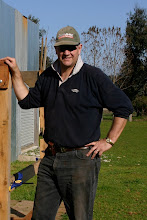[Turning an economically irrelevant annual gross farm income of $5,913 into $250,000 on a small farm just outside Melbourne]
So here's how we start episode 2.

The next step to relevance has to be how we sell the meat. This year I had a couple of steers that we'd grown - and a butch heifer that had failed to get in calf twice. We sent them to the saleyards at Kyneton on a cold July day when there was not a lot available - and we got $1-80 kg live weight for the steers and a little less for the heifer.
As it happens, that was considered a pretty good price. But I had no idea when I consigned the stock what sort of yarding there would be. I knew my animals were in good knick - and should eat well, but with me in Jakarta, I couldn't really bring them home if the prices were depressed that day. I was the classic price taker.

Farmers tend to be price takers almost all the time. It's a tough position to be in - when buyers are supposed to be on a level playing field, but are not.
Now let's get one thing clear - I believe (deeply, passionately) in markets as the most efficient way of allocating things to their best use. But I also know that perfect markets exist only only in economics text books.
I also think our food markets are about as screwed up as its possible to get. How and why this has happened is coming to be understood and, on one level, I'm interested in righting the wrongs, but I'm also aware that if I wait for the world to work 'fairly', I'll be waiting a long time.
I think the task is more to understand the way the system works and then attack the seams (as the old basketball coach used to say). Every system has it's weaknesses - including the food system.
When I sell at the Kyneton market, I'm feeding my meat into the industrial food system. I shouldn't be surprised when I get a low price. So I've got to find a way to sell my meat to consumers and dis-intermediate as much of the industrial agriculture / supermarket system as I can.
I think I'm fortunate in that the current system is now staggering under the weight of its own internal contradictions. Hell - we're fortunate because supermarkets deliver a fair bit of crappy food - including food that flat out makes us sick.
So I suspect the timing is right to look for ways of taking my 20 tonnes directly to the consumer. If I can do that, I've got 2 sources of income uplift:
- first the difference between the wholesale price of live stock and the current retail price of meat; and
- then there is the change in the price of agricultural produce that will occur as industrial agriculture collapses under the weight of it's own contradictions.
I'm still learning about this, but it seems that beef dressing out percentages are generally in the mid 50s and lamb in the low fifties. Overall I think it's reasonable to expect around 11 tonnes of saleable meat from 20 tonnes live weight.
Then there is the question of price. Rutherglen Lamb (a great product / service www.rutherglenlamb.com.au) sell a lamb for $220 and guarantee a minimum 12 kg. That highlights a second level of yield where parts of a carcasse can't be easily sold - these lambs will have started at about 42 kg, dressed out at (say) 22 kg and ended up as (say) 15 kg in the lamb pack.
I'm going to take a guess and say that at the retail level $1-80 a kg live weight becomes $5-00. This is just a bit less than the Rutherglen lamb ($220 / 42 live weight = $5-23). Lamb tends to be higher priced than beef - but the $5-23 takes no account of value in by products. Anyway - let's go with $5-00 / kg.
The addition then is $5-00 - $1-80 = $3-20 * 20 tonnes = $64,000. That's an extra 11 squares filled in.





No comments:
Post a Comment